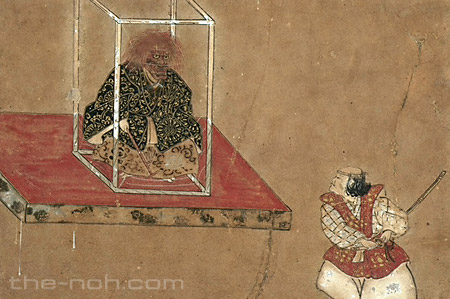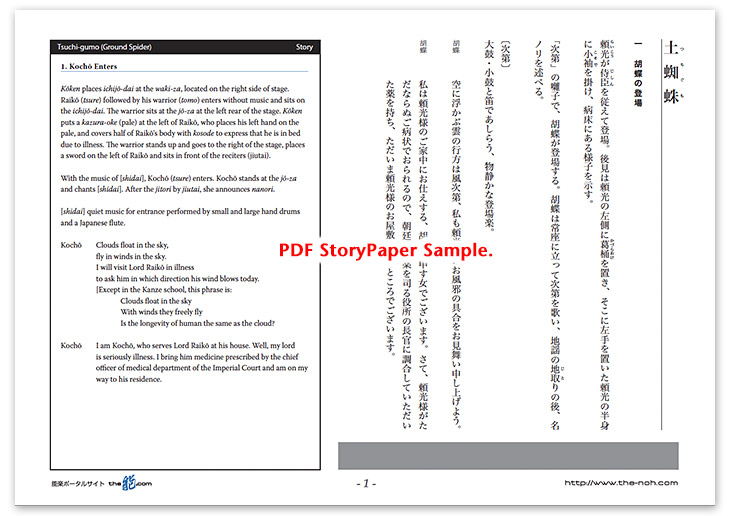
 Tsuchigumo (Ground Spider)
Tsuchigumo (Ground Spider)

![]()
To Minamoto no Raikō, who is ill in bed, his servant Kochō comes bringing prescribed medicine. However, his illness becomes more and more serious.
Deep in the night after Kochō leaves, an unknown monk visits the bedridden Raikō and inquires about his condition. Suspicious, Raikō asks the name of the monk, and the monk approaches Raikō reciting a poem in the Kokin-shū, "my love will visit me tonight, because a spider…" Looking closely, Raikō finds that it is a monstrous spider. Although the spider spins out thousands of silk threads to tie Raikō up, from his pillow side Raikō takes the great sword Hiza-maru, which has been passed down within the Genji clan. When he draws the sword and cuts the monster, the spider monk disappears instantly.
Hitorimusha, a warrior who serves Raikō, hears the commotion and rushes to Raikō's room with many of his followers. Raikō tells about the event and announces that he will change the name of the great hereditary sword from Hiza-maru to Kumokiri (Spider Slasher). Then Raikō tells Hitorimusha to exterminate the monstrous spider as he could not give it a death blow.
Hitorimusha and other servants follow the blood spots of the monstrous ground spider to an old mound, which seems to be the nest of the spider. The ground spider appears when they demolish the mound. The ground spider gives them troubles with its silk threads. However, Hitorimusha's entourage encircle it in strength and finally slay it.
![]()
Minamoto no Raikō was the chief of the Seiwa Genji clan in the mid-Heian period. He was also famous as a demon slayer. In addition to Tsuchi-gumo, other noh dramas such as Ōeyama and Rashōmon also refer to the legends of Raikō. However, the feature of these stories is that it is not Raikō himself but his warriors, such as Raikō's Four Great Warriors (Watanabe no Tsuna, Sakata no Kintoki, Usui no Sadamitsu, Urabe no Suetake) or Hitorimusha, who play the role of the monster slayer. The origin of the legends of Raikō seems to derive from the stories of great swords inherited by the Genji clan. In Tsuchigumo, the episode of the renaming of Hiza-maru as Kumokiri is introduced.
The highlight of Tsuchigumo is the scene in which the shite throws spider threads made of Japanese paper. It is said that the current performance which throws a number of threads is created by the grand master of the Kongoh school in the early Meiji period. The parabolic arch of the spider thread flying in the air contains strong entertainment value and is visually spectacular.
This noh drama increases in liveliness when the balance is maintained between three roles: shite, who performs an eerie monster in maeba; Raikō, who has to show the nobleness and dignity as the chief of the Genji clan; and Hitorimusha, who is the main character in the slaying of the monster.
STORY PAPER : Tsuchigumo (Ground Spider)
Story Paper presents noh chant stories in modern speech, with story outlines, highlights and more using Adobe PDF format, which can print out and zoom in. Print out the pages and take them with you when you see the actual noh performance.

The copyright of Story Paper is held by the Noh.com. Story Paper is for individual use only. It is prohibited by the copyright law to distribute or publish printed-out Story Paper pages without prior consent. For more information, check the credit and disclaimer pages.



 [Tsuchigumo (Ground Spider) : Story Paper PDF : 560KB
[Tsuchigumo (Ground Spider) : Story Paper PDF : 560KB